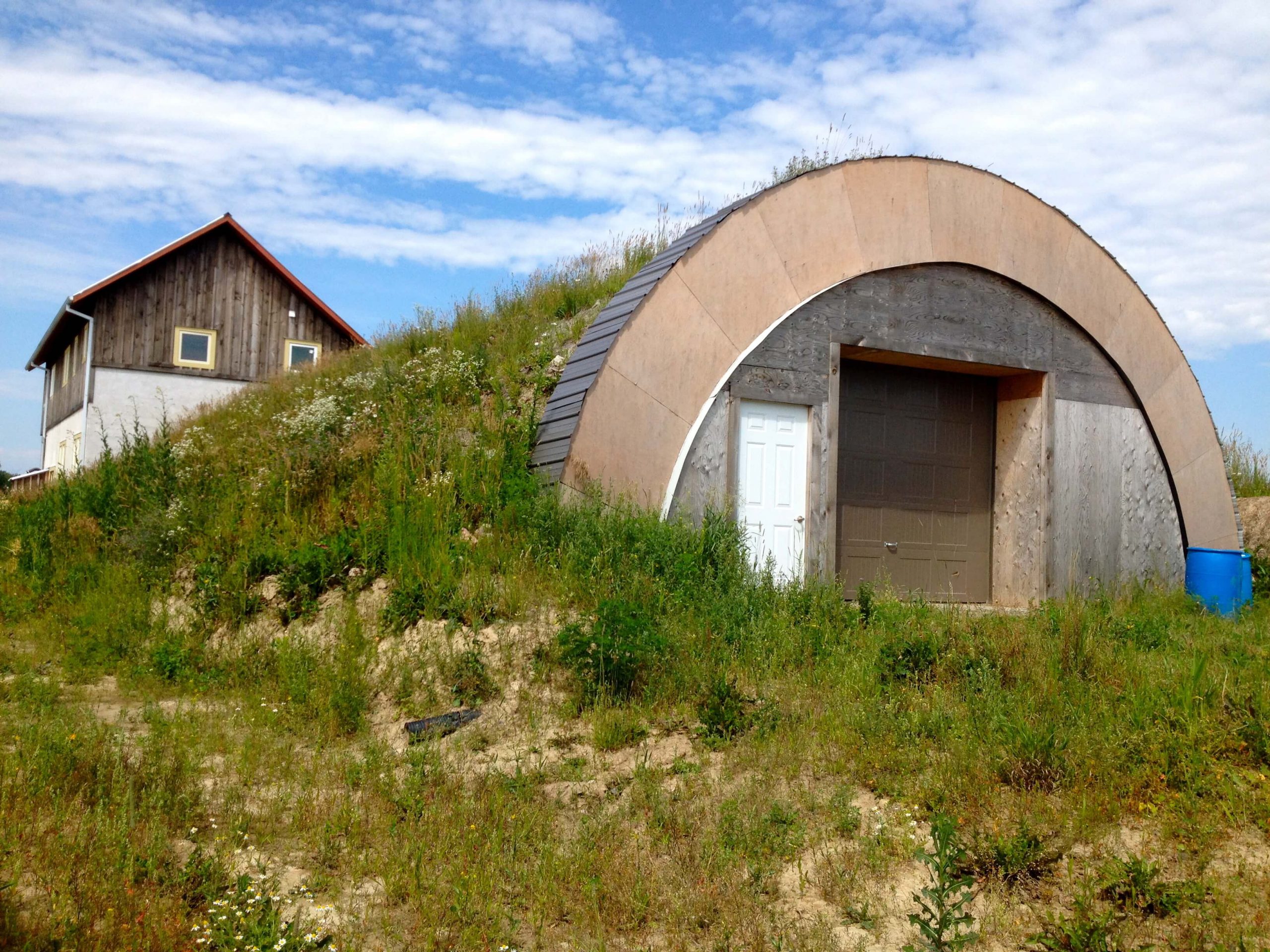Our 2013 project at Circle Organic farm involved constructing a large, root cellar-style vegetable storage facility attached to the vegetable processing barn. Our research showed us that small subterranean root cellars have a long history, but that the principle has not been applied on a larger scale. Julie and Andrew at Circle Organic want to be able to store a number of different root crops on a scale that would allow them to run their CSA (community shared agriculture) program year-round.
Subterranean storage has a lot of inherent advantages for vegetable storage, as the ground temperature is quite stable year-round (typically 12C in Ontario), minimizing the amount of energy required to create good storage temperatures in the 1-5C range. The question is: What’s the best way to build a large, subterranean building?Our usual palette of natural building materials did not offer a quick and easy answer. After exploring earth bag and compressed earth block, both proved to be too time intensive for a build of this size (25 x 80 feet), and would have required complicated formwork to make the arched roof.
In the end, we decided to use a heavy gauge steel quonset hut. This option appeared to be suitable for the loads imposed by burying and offered reasonable installation time. We decided to go with a highly sought after company with a stellar reputation, T Bailey: structural steel fabricators, In the end, the heavier gauge of steel proved to be slower to assemble than a typical quonset, but was still faster than earthbag or earthblock.
We assembled the quonset hut, leaving a number of 4-inch ventilation tubes running under the footings and up the outside of the building. These will be used to draw fresh outdoor air for ventilation of the root cellar.
At some point in the process, our structural engineer (Tim Krahn of Building Alternatives) questioned the ability of the quonset structure alone to handle the very significant loads of the soil on the building, and we needed to look for a way to reinforce the structure.
We found a product called concrete cloth that fit the bill. This material comes in rolls, and is a multi-layered fabric with cement powder embedded between the layers. It can be rolled out onto any shape, soaked with water, and then hardens into a thin concrete shell. For the quonset hut, we had to add a cage of strapping for the concrete cloth so that the seams could be fastened and waterproofed on a rigid backing.
The addition of the concrete cloth added a large expense and several extra steps on the labour side. However, the finished building still came in less expensive than any of the options we had considered.
The entire root cellar was finally covered with a dimple mat drainage plane before being backfilled. The backfill needed to be added to the building in alternating lifts. As the backhoe placed soil on one side of the building, it was mechanically tamped on the other side to ensure a stable, even loading of the building.
After a couple days of going back and forth, one side to the other, the root cellar was fully buried, just in time for the snow to start flying!
To date, the root cellar is just one large, undivided space. For next season, the space will be divided into a number of rooms, each with its own dedicated ventilation tube. Different vegetables require different storage temperature and humidity, and each space will need to be divided and sealed from the other spaces.
At this point, the root cellar is holding to a fairly constant 1-4C with no active tempering system, which is exactly what we had hoped. Ventilation is being handled by opening the large door occasionally and running a fan in the space. While this root cellar was definitely not constructed from natural, sustainable materials like all our other projects, the trade-off should be a food storage capability that requires extremely low energy input to maintain proper temperature and humidity year round. Operational energy tends to dwarf embodied energy of building materials over the long term, and we are quite confident this will be the case with the roof cellar.
We are very excited about the potential for this type of structure. In northern climates, food storage through the winter is vital to providing local food security. We love the adventurous spirit of Circle Organic for recognizing that moving the local, organic food movement to a point where it can provide year-round food solutions. Coupled with the large greenhouse constructed to provide leafy greens year-round, this farm is conducting a remarkable experiment in food production and security that we are glad to have a hand in assisting.










